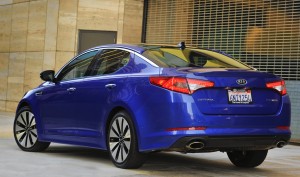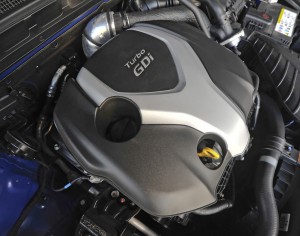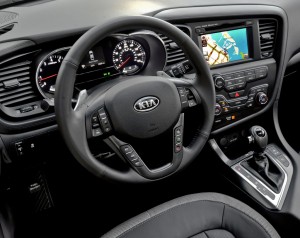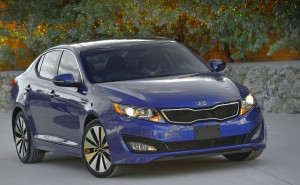
Kia's Optima Turbo shows that a small four cylinder turbo can replace the V-6 as the performance option for midsize sedans.
For several years, the engine formula for your basic midsize sedan was fairly well known. The standard model came with a four cylinder, but a V-6 was optional.
But in 2010, Kia – and it’s sister brand, Hyundai – changed that formula by announcing that its new Optima would only come with four-holers. No V-6 would be offered. Instead, the optional performance engine would be a little 2.0-liter turbo.
It’s become a familiar refrain in the auto industry. Redesigned models are ditching larger engines for smaller ones, often with high-tech features, allowing them to make horsepower similar to their larger predecessors.
Kia’s answer for replacing that V-6 is one impressive little mill. Direct injection allows a 9.5:1 compression engine, which is stratospheric for a turbo engine. Pumping out 274 horsepower – remember, this is just a 2.0-liter – the engine also delivers excellent fuel economy. It’s rated at 22 city and 34 highway. We saw a 25 mpg on mostly freeways and rural two-lanes.
But V-6 buyers also paid the premium to gain a little smoother engine. Could a four cylinder really stand in for a six’s creaminess?
In a word: yes. In fact, the powerful little engine turns what was already a fine midsize sedan into a nearly complete stunner.
The Optima’s standard engine is a 2.4-liter four cylinder making 200 horsepower, provides decent acceleration. But the smaller turbo motor’s extra 74 horsepower turns the Optima in a screamer.
And scream it does. It happily revs to its 6,500 rpm redline and feels smoother than its four cylinders would indicate.
Often, turbo motors suffer from lag as the turbo spools up to provide boost. If there is any lag in this turbo, it’s completely masked by the slick-shifting, regular slushbox six-speed automatic in the Optima. The transmission has quick manumatic shifting via a slot off the regular shift pattern and with shift paddles behind the steering wheel. Kia should steal Mitsubishi’s magnesium paddles and put them in place the plastic ones in the Optima.
Unfortunately, the Optima’s handling shows a continuing deficiency for the Korean duo. Many recently tested Hyundais and Kias have suffered from a ride that is too harsh. But the Optima’s problem is different. It rides smoothly, but there’s too much body roll, so the Optima doesn’t feel composed when in a hurry. Mash the throttle and the Optima unloads its front tires – remember, those are the ones putting all that power to the pavement – reducing the feeling of control. And with that much power underfoot, you want control.
It would seem that stiffer shocks would provide more confident handling.
At least torque steer is well managed.
If the handling comes up a bit short, the same cannot be said about the interior. Other than a couple of oddities, the Optima’s interior is a delightful place to do business. The seats are long-haul comfortable, but have decent bolstering to keep you in place in spirited driving.
Excellent white on black gauges are highly legible. Everything works with a silky precision. The easy-to-use infotainment system – controllable by voice – needs to provide basics of the climate control and stereo on the map screen.
Oh, and those oddities? Push the Optima’s start button and the seatbelt chime instantly goes off. Can’t we have a few seconds before the seatbelt nannies start blaring? That might be a setting that the dealer could change. But even weirder is the instrument panel’s info screen that warns the driver to “align the wheels” if slightly askew when started. Really? Optima drivers need to be reminded that front wheels are turned?
The back seat has spacious leg room, but headroom in the double sunroof-equipped test car, is slightly lacking.
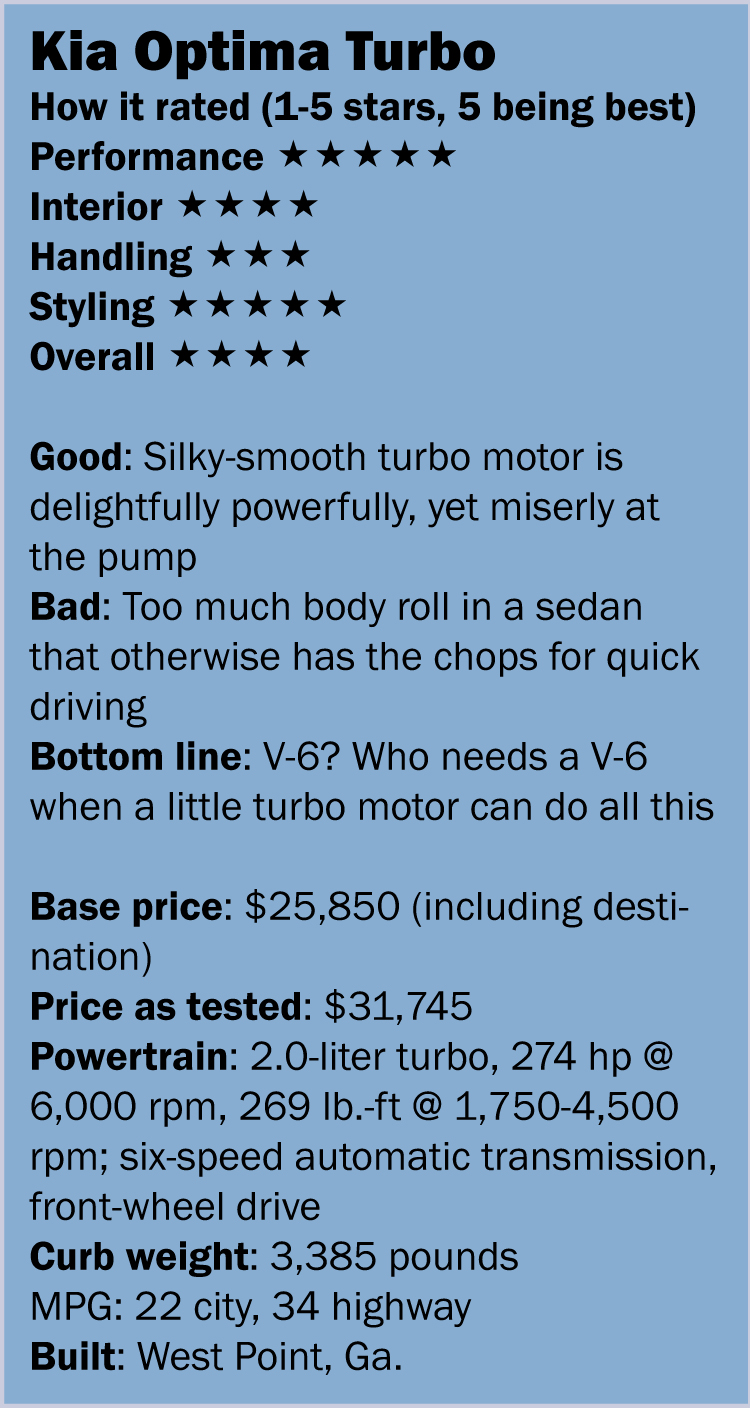 Maybe the most important part of Kia/Hyundai’s recent surge is the styling. The Korean automakers’ first offerings in the U.S. were strangely baroque. Subsequent models ranged from slightly strange to downright boring.
Maybe the most important part of Kia/Hyundai’s recent surge is the styling. The Korean automakers’ first offerings in the U.S. were strangely baroque. Subsequent models ranged from slightly strange to downright boring.
But no more. The current range of Kias have a sharp, technical style that turns heads wherever they go. They provide a nice contrast to Hyundais, which have graceful, arcing lines.
Even though Kia has given buyers a multitude of new reasons to give them a look, the automaker is still pricing them for the sale rack. Starting at $27,250, including destination, the Optima turbo comes standard with a laundry list of equipment including Bluetooth, leather, power driver’s seat, push button start and keyless entry, plus an alphabet soup of safety features including ABS, traction control (TCS), hill assist control (HAC) and six airbags.
Navigation adds $1,400 and the $2,950 SX premium touring package includes the sunroof, power-folding outside mirrors, Infinity eight-speaker stereo, power front passenger seat, heated and cooled front seats, heated outboard rear seats, rear camera, HD radio, UVO in-vehicle infotainment and 18-inch “luxury design” alloy wheels. Add in a few odds and ends for an as-tested price of $31.745.
The Koreans have upped their game with stylish, technically advanced cars. The last detail where they truly need to become world class is in suspension tuning. You can expect that they will get there sooner rather than later.

